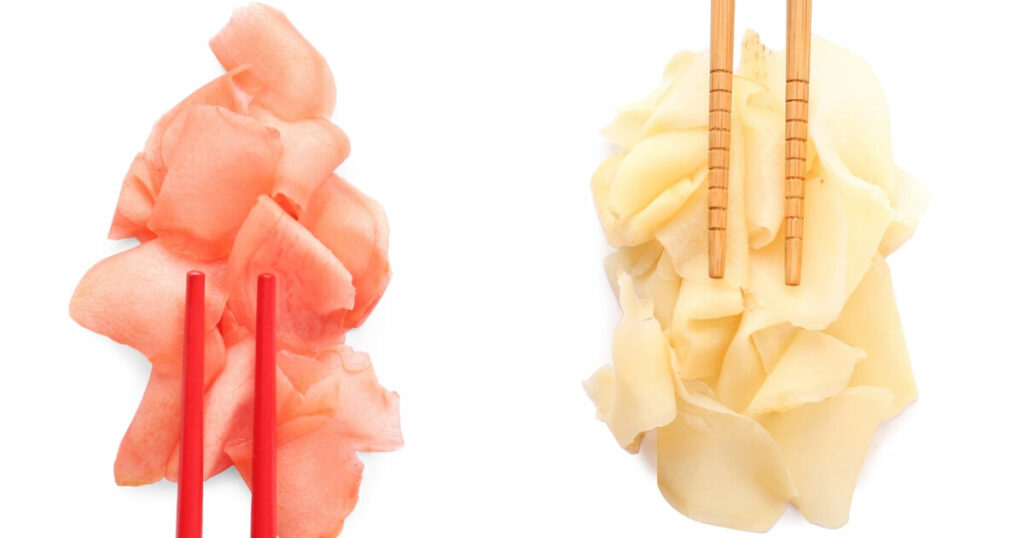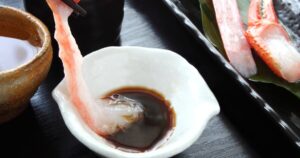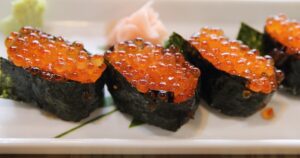Pickled ginger, or ‘gari’ as it’s known in Japan, is a type of tsukemono (Japanese pickled vegetable). It’s often served as a palate cleanser with sushi, but its uses extend far beyond that.
The taste of pickled ginger is a beautiful blend of sweet and sour notes and spiciness from the ginger. The pickling process gives it a mild sourness that perfectly complements its inherent sweetness.
Now, you might be wondering, “What’s so special about pickled ginger?” Well, in this article, we’ll talk more about this fascinating ingredient.
What Does Pickled Ginger Taste Like?
Imagine biting into a thin slice of pickled ginger. You’ll first notice its refreshing sweetness, a gentle introduction to the flavor journey you’re about to embark on.

This sweetness is quickly followed by a tangy kick resulting from the pickling process that gives the ginger its characteristic sourness.
But just when you think you’ve got a handle on its flavor, the ginger surprises you with a subtle hint of spiciness, a gentle reminder of its roots (pun intended!).
The aroma of pickled ginger is just as enticing as its taste. It has a fresh, almost floral scent with a hint of sharpness that’s characteristic of ginger. It’s the kind of aroma that makes your mouth water in anticipation, a perfect prelude to pickled ginger’s flavor explosion.
Types Of Pickled Ginger

There are several varieties of pickled ginger, each with its own unique flavor profile:
- Gari: This is the type of pickled ginger most commonly served with sushi. It’s known for its sweet and tangy flavor with a hint of spiciness. Gari is often dyed pink using red shiso leaves, giving it its characteristic color.
- Beni Shoga: This type of pickled ginger is made using mature ginger and is pickled in umezu, the brine used to make umeboshi (pickled plums). Beni shoga has a sharper, more robust flavor than gari and is typically served with dishes like yakisoba and okonomiyaki.
- Amazu Shoga: This variety is similar to gari, but it’s made with young ginger and pickled in a sweet vinegar solution. Amazu shoga has a milder, sweeter flavor than other pickled ginger types.
What Does Pickled Ginger Compare With?
There are a few other pickled items and ingredients that share some similarities with pickled ginger:
- Pickled Radish: Like pickled ginger, pickled radish has a sweet and tangy flavor. However, it has a crunchier texture and a more robust flavor.
- Kimchi: This is a Korean staple made by fermenting cabbage with spices. While it’s spicier and has a more complex flavor profile than pickled ginger, it shares the same tanginess and is also used as a side dish to cleanse the palate.
- Sauerkraut: This fermented cabbage dish is tangy and sour, like pickled ginger. However, it lacks the sweetness and spiciness of pickled ginger.
- Pickled Onions: These have a sweet and sour flavor similar to pickled ginger. They’re often used as a condiment or garnish in various dishes.
Why Is Pickled Ginger Eaten With Sushi?
The pickled ginger isn’t typically incorporated into the sushi roll itself, but rather, it’s served on the side of the sushi platter.
The pickled ginger, often a light pink color due to the pickling process, is thinly sliced and served in a small pile. It’s a beautiful sight, with the vibrant, almost translucent color of the ginger contrasting against the various hues of the sushi rolls.
The role of pickled ginger in a sushi meal is to cleanse the palate between different types of sushi. This allows you to fully appreciate the unique flavors of each sushi roll.
After a bite of sushi, a small piece of pickled ginger is eaten to refresh the mouth and prepare it for the next flavor.
While pickled ginger is a staple in traditional sushi meals, there are a few variations that incorporate pickled ginger in different ways:
- Sushi Rolls – In some modern sushi rolls, pickled ginger is incorporated directly into the roll. This gives the sushi roll a unique flavor profile, with the tangy pickled ginger complementing the other ingredients in the roll.
- Sushi Bowls – Pickled ginger is used as a garnish in sushi bowls. The sushi bowl typically consists of rice, various fish, and vegetables, with pickled ginger sprinkled on top for an added flavor.
- Sushi Hand Rolls – Pickled ginger can be added as fillings in sushi hand rolls. The tangy flavor of the pickled ginger pairs well with the savory fillings, adding a refreshing twist to the hand roll.
Pickled Ginger FAQs
What does pickled ginger taste like?
Pickled ginger has a delightful blend of sweet and tangy flavors, with a hint of spiciness that comes from the ginger itself.
What is the point of pickled ginger?
The main purpose of pickled ginger is to cleanse the palate. It’s served with sushi to refresh the mouth between different sushi types, allowing each roll’s unique flavors to shine. Additionally, pickled ginger adds a vibrant flavor to any dish it’s served with.
My Tasty Thoughts
The sweet, tangy flavor of the ginger works wonders in cleansing the palate, allowing you to fully appreciate the delicate flavors of the sushi. It’s like a refreshing gust of wind that sweeps away the remnants of the previous bite, preparing your palate for the next.
But don’t let tradition limit your culinary creativity! Pickled ginger can also be a fantastic addition to salads, stir-fries, and even sandwiches. Its vibrant flavor can add a new dimension to your dishes, making every bite an adventure.


